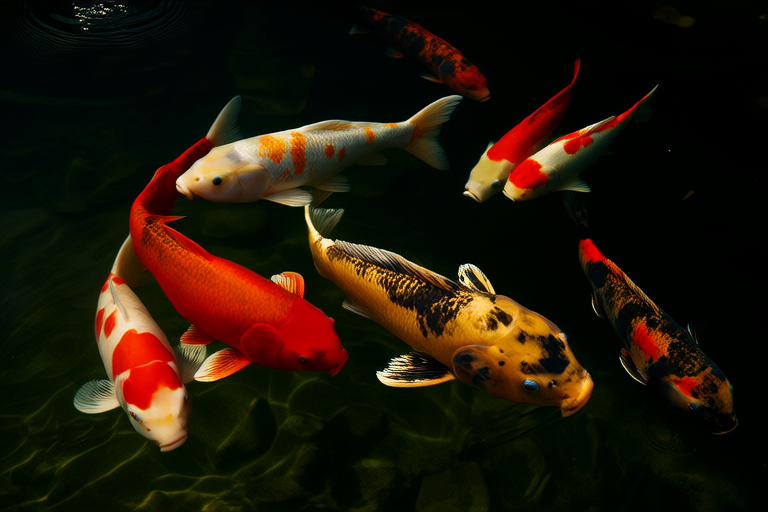Secrets to Enhancing Growth and Vibrant Colors in Your Koi
Welcome to the fascinating world of koi keeping! Whether you’re a novice or an experienced enthusiast, there’s always more to learn about ensuring your koi grow strong and vibrant. This guide offers expert advice on optimal feeding practices, water quality management, suitable pond environments, sunlight exposure, and regular health checks. We’ll emphasize natural and sustainable methods to promote koi growth and color enhancement, providing real-life examples and practical tips for all levels of koi keepers.
Optimal Feeding Practices
Proper nutrition is essential for your koi’s overall health and vibrant colors. A balanced diet consisting of high-quality pellets, flakes, and occasional live foods like bloodworms or brine shrimp will support healthy growth. Feed your koi small amounts multiple times daily during warmer months when they are most active, and reduce feedings as temperatures drop in winter.
Novice koi keepers might be tempted to overfeed, but this can lead to poor water quality and digestive issues. Experienced koi enthusiasts know that less is often more; observe your fish closely and adjust feedings accordingly. Remember that koi are opportunistic feeders, so it’s easy to overestimate their hunger. Aim to feed them only what they can consume within five minutes.
For example, John from Springfield noticed his koi’s colors fading after a summer of generous feedings. By reducing portion sizes and increasing the frequency of smaller meals, he saw his fish regain their luster within weeks.
Water Quality Management
Maintaining excellent water quality is crucial for your koi’s well-being. Regularly test the pH, ammonia, nitrite, and nitrate levels in your pond to ensure they remain within safe ranges. Perform partial water changes weekly or bi-weekly depending on the size of your pond and stocking density. Use beneficial bacteria products to help break down waste and maintain a stable ecosystem.
Experts recommend using mechanical filtration systems combined with biological filters to remove debris and harmful substances while promoting beneficial microorganisms. Avoid harsh chemicals that could harm your koi or disrupt the delicate balance of your pond’s ecosystem.
Linda from Boulder shares her experience: “I started noticing algae blooms despite using algaecides. After switching to a natural approach with barley straw extracts and improving my filtration system, my pond became crystal clear again.”
Suitable Pond Environments
Your koi need ample space to swim comfortably and hide from predators. As a general rule, allow at least 10 gallons of water per inch of fully grown koi. Incorporate plants, rocks, and other structures to provide hiding spots and reduce stress. Choose hardy aquatic plants such as water hyacinths, iris, or lotus that won’t overcrowd your pond.
Ensure proper oxygenation by installing aerators or waterfalls. Koi require dissolved oxygen levels above 4 ppm (parts per million) for optimal health. During hot weather or periods of heavy feeding, consider supplemental aeration to prevent low oxygen conditions.
Mark from Miami found that adding submerged oxygenators like hornwort improved his koi’s activity levels and reduced surface agitation caused by gasping for air.
Sunlight Exposure
While koi enjoy basking in the sun, excessive exposure can cause skin damage and fade their colors. Provide shaded areas within your pond using floating plants, umbrellas, or artificial shelters. Aim for a balance between sunlight and shade, allowing your koi access to both throughout the day.
Expert advice suggests rotating your koi’s positions within the pond if possible, ensuring each fish has equal opportunity to benefit from both sunlight and shade. This helps maintain even coloration across their bodies.
Susan from Seattle discovered that moving her koi around the pond during different seasons helped preserve their vibrant hues. She now rotates them every few months based on changing light patterns.
Regular Health Checks
Monitor your koi regularly for signs of illness or injury. Look out for unusual behavior, lesions, fin rot, or excessive mucus production. If you notice any concerning symptoms, consult with a veterinarian specializing in exotic pets or seek advice from local koi clubs.
Establish a routine for cleaning your pond, including vacuuming gravel and removing debris. Keep records of treatments administered and any notable events affecting your koi’s health. This information can be invaluable when diagnosing potential issues.
Tom from Chicago learned the importance of keeping detailed records after losing several koi due to undiagnosed parasitic infections. He now maintains a comprehensive journal documenting daily observations and treatment histories.
Natural and Sustainable Methods
Promote natural and sustainable methods for enhancing your koi’s growth and color. Avoid synthetic additives and opt instead for organic fertilizers derived from composted materials. Encourage beneficial insects like dragonflies and damselflies which prey on mosquito larvae and other pests.
Consider integrating native fish species into your pond ecosystem to establish a balanced food chain. These additional inhabitants may compete with your koi for resources but also contribute positively by controlling populations of unwanted organisms.
Encouraging Reader Participation
We invite you to share your own experiences and insights regarding koi care. What strategies have worked best for you? Have you encountered challenges that others might benefit from hearing about? By sharing knowledge and supporting one another, we can continue learning together and fostering healthier, happier koi communities worldwide.
Remember, koi keeping is not just about maintaining beautiful fish; it’s also about creating a harmonious environment where both humans and animals thrive. With dedication, patience, and continuous learning, you too can enjoy the rewarding experience of raising vibrant, thriving koi.
